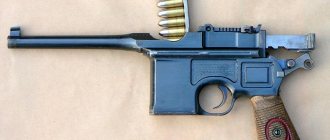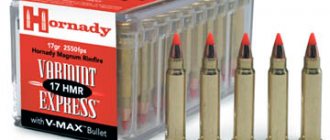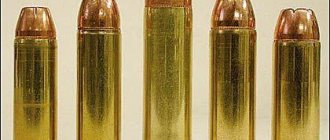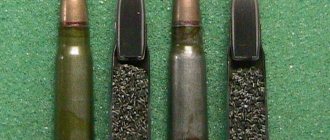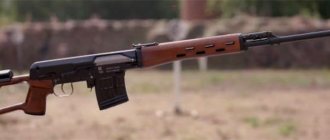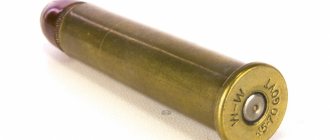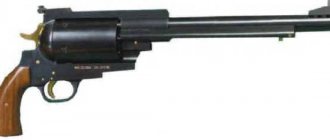According to experts, firearms include all barreled small arms with a caliber of no more than 20 mm. If this indicator is higher, then the shooting is no longer carried out with a bullet, but with a shell. Such weapons are considered small-caliber artillery. The design of such rifle units does not contain devices whose task is to dampen the recoil impulse. As a result, such weapons have a very stopping effect.
Judging by numerous reviews, the 45 caliber is very popular among military and civilians. On the shelves of specialized stores are presented firearms models of pistol and revolver systems that use this ammunition. Information about 45 caliber ammunition, advantages and disadvantages is contained in the article.
Acquaintance
Today there are several standards for measuring the caliber of weapons. In this regard, often, when comparing a 45 caliber with a 16, the first may turn out to be smaller. In European countries and Russia, the metric scheme in millimeters is used for measurement. Calculate using the diameter of the trunk. Therefore, in rifled weapons, taking into account the depth of the rifling, the cartridge is slightly larger than in smooth-bore weapons. In Britain and the United States, fractions of an inch are used as a unit of measurement: in the USA, hundredths, in England - thousandths. For this reason, the American .45 caliber is listed as .450 in the UK. In Russia it is 11.43rd.
"Raber AS"
The target range of Raber AS bullets is 15 m. The muzzle energy of this model is 2700 J, sufficient for use in traumatic weapons in the winter season. The cartridges weigh 7 g, which corresponds to the average characteristics and other modifications of the series. Easy to use, does not create difficulties when charging. The manufacturer chose an unusual material for making the sleeve - nickel. P
The hive is also standard - a rubber ball. "Raber AS" is popular due to its low price; it goes on sale in boxes of 20 copies.
About the characteristics
- 45 ACP is a type of pistol cartridge.
- Manufactured in the United States.
- The ammunition was created in 1904 and produced since 1905.
- The total length is 3.24 cm.
- The projectile weighs 15.16 g.
- The length of the sleeve is 22.81 mm, the diameter of its neck is 1.2 cm, the base is 12.09 mm, the flange is 12.19 mm.
- The ammunition is provided with a powder charge weighing from 0.34 to 0.37 g.
- A bullet fired from a barrel has an initial speed of no more than 271 m/s.
- During firing, an energy of 544 J is generated.
"Raber LT"
Another popular model with average characteristics. The power of the muzzle energy is at the level of 2600 J. The bullet is capable of reaching a speed of 270 m per second. when leaving the barrel. The core of the cartridges is made of steel, which gives it strength. Ammunition of this brand shows good results both in summer and winter. When shooting at a distance exceeding 30 m, the hit effectiveness drops; up to 10 m you can count on satisfactory effectiveness. Sold in a box of 20 units.
About the advantages
According to experts, the 45 ACP cartridge has the following strengths:
- Ammunition projectile with very high stopping power. This indicator does not decrease even if a conventional jacketed bullet is used.
- Shooting a .45 caliber pistol involves heavy recoil. However, judging by numerous reviews, when using 45 ACP it is quite moderate. The owners appreciated the comfortable shooting with this ammunition.
- The cartridge provides high accuracy.
About weaknesses
Despite the presence of undeniable advantages, 45 ACP is not without some disadvantages. The weaknesses of the cartridge include the following:
- High cost.
- Large weight and increased dimensions of ammunition.
- Due to the low initial speed and penetrating properties of 45 ACP, it has low destructive power.
- Bullets have a short firing range. With submachine guns you can hit a target from a distance of up to 70 m, with pistols - up to 30.
According to many experts, the demand for 45 ACPs is growing rapidly. This is due to the fact that new bullet variants have been developed for this cartridge. Judging by the reviews, expansive projectiles with controlled expansion are very popular among many shooters. Thus, having hit the body and penetrated to a certain depth, the bullet begins to unfold.
Small caliber cartridge
So, we looked at the table of weapon calibers. The most popular rifled civilian weapon among novice hunters is .22 LR or 5.6 millimeters. It is used for shooting small animals, such as fur-bearing wild animals and rodents. This ammunition is also widely used in sports.
5.6mm cartridges and weapons were first demonstrated by the J. Stevens Arm & Tool Company in the late 19th century. They were originally intended for indoor shooting at paper targets. It is worth noting that the first 5.6 mm cartridge was a piston, which was placed in a copper cup. Small shot also fell there. Subsequently, various enterprises produced different variations of the cartridge with a bullet with a diameter of 5.6 millimeters. The length of the sleeve changed, as well as the filling options for the projectile for throwing. Today there are several types of this ammunition left:
- .22 Winchester Magnum Rimfire.
- .22 Short.
- .22 Long.
- .22 Long Rifle.
The last type is the most popular. It is equipped with a bullet weighing 2.6 grams. The initial speed of the projectile reaches 410 meters per second. Muzzle energy is about 190 J. The maximum range of guaranteed target destruction is 150 meters.
The popularity of the .22 LR cartridge is explained by its high accuracy, quiet pop when fired, minimal recoil and low cost. The disadvantages include the following factors:
- lack of stopping effect;
- low projectile power.
About weapon systems
Rifle units are assembled on the basis of two main schemes: pistol and revolver. Each of them has both strengths and weaknesses. Judging by reviews from owners, modern pistols provide automatic shooting and fast and easy reloading. Revolvers are highly reliable and the owner does not need to send ammunition down the barrel after firing. In addition, in revolvers, cartridge case extraction is not carried out automatically. On the one hand, this can be considered a disadvantage, since the shooter will then have to open the drum and remove the cartridge case himself. On the other hand, according to experts, this design feature increases the secrecy of use, which is used by special forces officers. Below are several models of 45 caliber weapons.
M1911
From 1911 to 1985, the Colt 45 caliber was in service with the United States. In the technical documentation it is listed as M1911.
Due to the high stopping power of the bullet, this semi-automatic rifle was recognized as the best model of weapon for self-defense. The Colt M1911 was produced until 1982. During this time period, the pistol was modernized several times. Despite the fact that the M1911 was retired from service by the US Army in 1985, many private owners still use it today. From 1911 to 1982 The United States gun industry produced three million units of this model. In addition, the M1911 was widely used by British, Soviet, Norwegian and French soldiers. The M1911 was also in service in Nicaragua and El Salvador. Estonia and Haiti have become those states where the 45-caliber Colt is used by the armies today.
Colt 1873
In 1872, the armory produced a rifle unit designed according to the revolver design. This model was fired with a unitary pistol cartridge.
In 1873, the 45 caliber revolver entered service with the United States. During the two decades that the American Army used this model, the US Armed Forces purchased more than 37 thousand rifle units. The revolver was produced in two versions: for the needs of the army, a 45 caliber was provided, and for civilian users, a 44 caliber. Since the 1890s, the production of revolvers has been suspended. Production was resumed only in the early 1950s. According to experts, the impetus for increasing consumer demand for the Colt 1873 was the popularization of Westerns by the American film industry.
As a result, revolver production was resumed in 1956, and it continues to this day.
MP 80 13T
In the line of various “trauma” weapons available on Russian arms counters, the non-combat rifle unit, which is listed in the technical documentation as MP 80 13T, is in great demand. The basis for this model was the legendary Makarov pistol. MP 80 13T is a 45 caliber “trauma”. Shooting is carried out with 45 Rubber cartridges. This shooting model, as many owners are convinced, is an excellent alternative to the 9-mm Makarych. Since the MP 80 13T uses ammunition with an increased caliber, Russian designers had to reduce the magazine capacity from 8 to 6 rounds. The ammunition is loaded with a 13-mm rubber bullet. During the shot, as the manufacturer assures, an energy of 90 J is generated. In fact, judging by numerous consumer reviews, this figure is slightly lower and varies from 70 to 80 J.
Unlike other “traumas” that use a smaller caliber, when firing from the MP 80 13T, due to the increased diameter of the projectile and the area of its contact, through holes are not formed. When hitting a target, 45 Rubber bullets leave only deep dents. For self-defense, this cartridge is considered the best option, since it will save the gun owner from problems with the law.
Historical detective. Caliber 45 mm
We continue the theme of historical investigations, since the debut turned out well. Today on the agenda is the issue of caliber. Caliber 45 millimeters, a caliber that existed in one and only country - the Soviet Union, in service with one army - the Red Army.
And here there are not just a lot of unevenness and roughness.
Let's start with the fact that for some reason the majority of researchers talk about a 45 mm anti-tank gun, completely ignoring the rest. Probably because Comrade Shirokorad didn’t write, and without him it’s difficult to swing, I agree.
But Shirokorad really wrote about the anti-tank gun, and wrote well. Which, however, is not a reason to forget all the other guns.
The rest are a tank gun, a battalion howitzer, an anti-aircraft gun, a semi-automatic universal gun, and a naval gun. And that’s it – 45 mm.
45-mm universal gun of the cruiser "Red Caucasus"
You will say that tank/anti-tank are the same thing. Well, yes, but the methods of attachment and movement are slightly different, as well as the shells that were used. Tanks fought with tanks only against not very good military leaders. Good tanks drilled pillboxes, bunkers and everything else, which mostly required high-explosive shells.
However, we have written quite a lot about this, there is nothing special to invent.
As an interim result, we note that 45 mm is not exclusively an anti-tank caliber of the Red Army. There were more than enough guns of this caliber, and this, I must say, greatly shakes the opinion of Alexander Borisovich, whom I respect.
Why? It's simple.
If you look at a single “forty-five”, then yes, everything fits, and the version works. If you look at the caliber as a whole, no, no, and no again.
So, the version of Shirokorad and followers.
The famous “forty-five” is the superimposition of a 37-mm 1-K anti-tank gun of the 1930 model on the carriage of its own barrel, bored to 45 mm.
Logically, the technique is as old as the world, nothing new. If the base allowed, we sharpened everything. Not only ours.
It’s also worth saying a few words about the 1-K gun itself, although we wrote about it. Yes, this is the same 3.7 cm anti-tank gun of the 1926 model, bought by the Soviet Union through a front gun. Bought “with giblets”, that is, with all possible technological documentation. For a little over a million (1.125 million, to be exact) dollars.
Only half a thousand 1-K guns were produced, but the military did not like the gun, it seemed downright weak (the Great Patriotic War confirmed this), and the gun was quickly replaced with a 19-K.
45 mm caliber... Although...
45-mm battalion gun designed by Sokolov. 1927
Currently, there are several versions about how this strange caliber was formed in our troops. There was a standard caliber of 47 mm in the world, why did everything turn out “not like everyone else”?
Version No. 1
Version No. 1 states that allegedly it was impossible to install a barrel from the same 47 mm gun on the carriage of a 37 mm gun, so it was cut down to 45 mm.
I don’t even want to criticize or dissect the version.
2 (TWO!) millimeters. On the gun carriage. What kind of admission is this that could not be accommodated? Or perhaps the 47-mm cannon had such a powerful projectile that the design of the carriage could not withstand it? Well, it’s more or less suitable, but I’ll cite a sign from an article about anti-tank guns of World War II. And there it is clear that the 45-mm gun is in no way inferior in terms of power to its 47-mm sisters. And some are even superior.
In any case, whether there are dimensional or strength flaws – well, it looks stupid.
The Hotchkiss gun produced an initial projectile speed of 701 m/s versus 760 m/s for the 1932/37 model gun.
Hotchkiss 47 mm gun
For an armor-piercing projectile the difference is not very critical, but for a high-explosive fragmentation projectile you don’t even need that much. This is evidenced by such a value as the mass of the powder charge: the Hotchkiss gun has 350 g, the “forty-five” armor-piercing shells up to 360 g. And the high-explosive fragmentation projectile ejected 100-115 g of gunpowder.
Version No. 2
Version No. 2 looks more serious, and is advocated by Shirokorad and other (very numerous) supporters on the forums. According to this version, supposedly after the revolution, a large amount of armor-piercing ammunition for the aforementioned 47-mm Hotchkiss naval gun accumulated in military warehouses.
Okay, there was such a gun. Yes, at that time it was completely outdated, and yes, its shells at sea were theoretically completely useless, so they decided to transfer them to land and use them as anti-tank/infantry support weapons. There weren't very many tanks at that time.
The whole problem is that the Hotchkiss anti-mine gun was originally designed to combat unarmored targets such as destroyers, boats and submarines. And bad luck, I didn’t find armor-piercing shells in the specifications for it. There were cast iron and steel grenades. So there is no obvious connection here.
The very idea of remodeling also looks strange.
Okay, they decided to clean out the warehouses, hand over the shells to the ground artillery, and let them suffer. It's so simple...
Grind the belts by 2 mm. Is it easy or what? This, I think, or what.
We need to unload the shell. That is, remove it from the sleeve. Then remove the fuse. Yes, just in case. And then you can tighten the projectile into the cartridge and grind the belt. Without a real prospect of getting caught in the explosion of this shell.
Next, reinsert the projectile into the cartridge case, restore the seal again, and yes, you can shoot.
I immediately have a question: wouldn’t it have been easier to just make a 47-mm cannon and not engage in perversions?
Now experts will begin to say that the Hotchkiss gun’s grenade flew at a speed of 700 m/s, the 19-K’s speed was already 760 m/s, and the M1932’s was 820 m/s. And the unfortunate belts could be torn off.
I agree, initial projectile velocities have increased. And it was quite possible to rip off the belts. However, there is a nuance here that spoils everything. Namely, a complete lack of data.
“There are a lot of shells in warehouses” - how many pieces? Nobody says the number. Yes, in principle, it is unrealistic to name it, because the Russian-Japanese, World War I, Civil War plus the eternal Russian mess.
The fact that 47 mm is useless became clear back in the Russo-Japanese War. It was not for nothing that hundreds of Hotchkiss guns were removed from ships, installed on at least some semblance of machine tools and sent to the front line in order to somehow compensate for the shortage of battalion and regimental guns.
And since an armor-piercing shell was completely useless for infantry in those years, it is not surprising that these shells were simply lying around in warehouses. It's logical, it's undeniable, it's normal.
Another question is how many are in grams... This is a complete mystery, but I think that there were quite a few of them there. If the tsar’s reserves were enough for half of the Great Patriotic War (76.2 mm), then 47-mm “goods” could have been in excess.
And here a dual feeling arises.
Well, if there are mountains of shells right there, take them and shoot - I return to the question of whether it would have been easier to make a barrel for shells. Simply, at Obukhovsky they deployed not such calibers.
Plus (very significant) it would be possible “if something happens” to intercept shells from the allies. During the First World War, both the British and the Americans supplied us with 76.2-mm shells, not exactly to the fullest extent, but they supplied us.
But if there are not so many shells, then it is quite possible to decide on such an adventure as regrinding a shell.
What are they lying there? Well, let them be useful, such shells can easily be used as combat training, why not? The benefits of the car, the savings are huge, training costs are reduced, let the artillerymen hit with this antiquity for training purposes...
But I repeat, it is very, very doubtful that it will be millions. I found a figure that on January 1, 1901, the Navy Department had 963 47-mm Hotchkiss guns. From this we conclude how many shells for a thousand guns could be in the warehouses.
And since we are talking about the fact that there were frankly few guns, it follows that there were hardly millions of shells lying around for them. A couple hundred thousand at most.
We are talking about the movements of the 30s of the last century, when the First World War, the Civil War, and the intervention had already died down. And they ate their shells.
So it turns out that the mosaic is not quite coming together.
Version No. 3
Version No. 3 says that the 45 mm caliber is actually a 47 mm caliber, but:
1. It was developed according to a cunning plan so that the enemy could not use our shells if something happened.
2. 45 mm is exactly the same 47 mm, but was simply measured differently. Ours measured by the distance between the opposite fields of the rifling, and abroad they measured from the bottom of the rifling groove to the bottom of the opposite groove.
Both cases are so-so. Finnish, World War II, and the Great Patriotic War showed that such an approach with calibers can and should be ignored and forgotten, since practice has shown that ammunition can usually be very easily provided with captured guns and vice versa.
As for such aspects of measurement... You still can’t get such a difference, that’s why a lathe was needed in order to remove the copper bands and turn the projectile into a 45 mm one.
Own version
I don’t think I’ll reveal any such secret, but it seems to me that ours simply borrowed the idea of a 45 mm caliber.
So many things in that difficult time for the country. Especially regarding artillery. Buying is not a question if you were selling. More often than not they didn't sell. But it is a fact that the intelligence of the Soviet Union worked, God willing, to others.
It turned out when selecting material for this article that developments in Russia for 40-47 mm calibers were carried out before the revolution. There was a very interesting project by Lichonin, unified with the Hotchkiss gun; Lander worked in this direction.
Then, of course, there was no time for development.
Meanwhile, the West also did not sit idly by. Especially the French, who are not tied by their hands, unlike the Germans. And the French, in the works of Saint-Chamon and Nordenfeld, used calibers from 42 to 45 millimeters.
Honestly, I don’t know how this caliber was calculated, but somehow the designers came to the conclusion that for a battalion-use gun (the so-called trench guns), a caliber of 40-45 mm would be optimal.
The guns of Nordenfeld and Saint-Chamond were not accepted for service. And this may be where such a nuance lies, since we, too, have begun to strive towards creating a weapon of the future.
Research work was carried out by Lander back in 1916, there were developments. The new gun was supposed to replace the 37 mm trench guns and adapted Hotchkiss naval guns.
Franz Franzievich Lander proposed a 42 mm caliber as a working option, but obviously they decided to make the gun more powerful, so they approved 45 mm.
Apparently, for a reason. It is possible that an opportunity has arisen to become acquainted with the works of Nordenfeld and Saint-Chamond. I admit it, because it was in those years that our intelligence service worked like hell.
As a result, in 1929 (yup, they started in 1916, continued virtually from scratch in 1922, and here you are) a 45 mm battalion howitzer of the 1929 model came into service.
And in addition to the howitzer, a certain “BM gun”, that is, of high power, was also discussed. The BM did not go into production, but after some time the work on it was used in the rework of 1-K.
But I will argue about redesigning the projectile. Lander, according to the order, developed a 45 mm HE projectile back in 1916. This means that the 47-mm shell from Hotchkiss had absolutely nothing to do with it. The projectile was 45 mm, and the guns were developed based on it.
And this is very logical.
Who consumes HE shells? Anti-aircraft guns? Yes. Tanks? Yes. Infantry support guns? Yes. Howitzers? Yes!
The exceptions are indeed anti-tank and naval guns. Well, tank ones to a lesser extent.
This means that industry, long before all this noise around Hotchkiss shells, was geared up to produce 45 mm shells.
And this is a fact that is difficult to escape. The armor-piercing shells were not met with success, since the nomenclature implied that they would fire not only at tanks.
The range of shots from 45 mm guns was as follows:
Armor-piercing: 53-B-240 Armor-piercing-tracer: 53-BR-240 Armor-piercing-tracer: 53-BR-240SP (solid) Armor-piercing-tracer sub-caliber: 53-BR-240P Fragmentation: 53-O-240 (steel) Fragmentation: 53-О-240А (steel cast iron) Buckshot: 53-Ш-240 Smoke: 53-Д-240
Plus a line of shots for anti-aircraft guns:
Fragmentation tracer: O-333, OR-73, OR-73A High explosive: O-240
What is the conclusion? And the conclusion is very simple: the 45 mm caliber was determined by anything other than the desire to use supposedly huge reserves of 47 mm armor-piercing shells. Because, in addition to armor-piercing ones, it was necessary to produce the entire range of shells listed above.
And they released. And in huge quantities, because the unitary 45-mm cartridge was used everywhere: by artillerymen, tank crews, anti-aircraft gunners, and sailors. One should not write off the entire submarine fleet of the Red Army, armed with 45-mm universal guns. As well as battleships, cruisers, leaders, destroyers, minesweepers, hunters and so on.
Compared to the huge amount of shells that had to be fired for ALL 45 mm guns, a drop of 47 mm shells from the Hotchkiss guns was exactly what it was.
Moreover, the ground off belts, which were supposed to cut into the rifling, thereby improving compression and twisting the projectile around its axis, were unlikely to have a positive effect on ballistics. Rather, on the contrary, they worsened, and so much so that it was difficult to demand anything truly combat-ready from these shells.
I am sure that the only use they found was for target practice. This crippled projectile was hardly suitable for more.
Therefore, I think it is possible to voice the following conclusion:
1. The 45 mm caliber was a pre-revolutionary development of Russian engineers.
2. We returned to the project when the opportunity arose. Probably not without the help of intelligence and foreign developments.
3. Regrinding 47 mm shells for 45 mm caliber is nothing more than a successful attempt to attach shells that were actually useless at that time. Maximum useful disposal.
This is the opinion.
